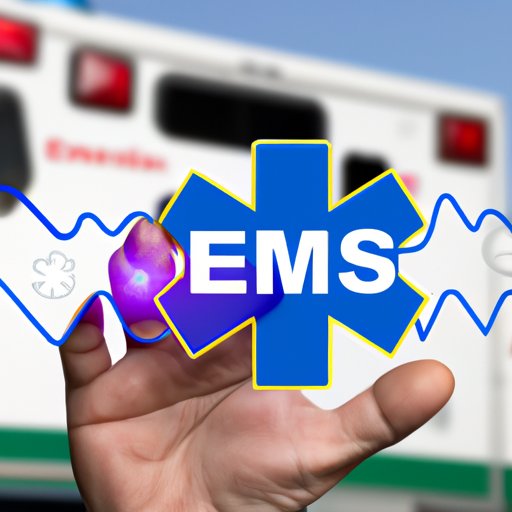Introduction
Emergency medical services (EMS) technology is a rapidly evolving field that has revolutionized how medical care is provided in emergency situations. With the help of EMS technology, healthcare providers are better equipped to handle the most urgent medical emergencies, while also improving patient outcomes and overall public safety. In this article, we will explore what EMS technology is, the various types of EMS technologies and their applications, and how these technologies are having a positive impact on healthcare, emergency response, and public safety.

An Overview of EMS Technologies and Their Applications
EMS technology includes a variety of devices and systems that are used to provide emergency medical services. This includes everything from patient monitors and defibrillators to communication systems and navigation systems. These technologies enable healthcare providers to respond quickly and effectively to medical emergencies, and can make a huge difference in the outcomes of those who require emergency medical attention.
The most common type of EMS technology is patient monitoring devices. These devices track vital signs such as heart rate, blood pressure, oxygen saturation, and other important information. This data is then relayed to healthcare providers, enabling them to make quick and accurate decisions about how to best treat the patient. Other types of EMS technology include defibrillators, which can be used to shock a patient’s heart back into rhythm, and communication systems, which allow for instant communication between healthcare professionals.
In addition to these technologies, there are also navigation systems, which allow healthcare providers to find the quickest route to the patient, as well as software programs that can be used to manage patient records and keep track of treatments. All of these technologies are essential for providing quality emergency medical care.

Understanding How EMS Technology Impacts Healthcare
EMS technology has had a significant impact on healthcare by improving the quality of care that is provided to patients. By utilizing advanced monitoring devices, healthcare providers can more accurately assess a patient’s condition and provide the necessary treatment in a timely manner. This leads to improved patient outcomes and reduced mortality rates.
In addition, EMS technology has also made healthcare more efficient. By streamlining the process of collecting and analyzing patient data, healthcare providers can make decisions faster, leading to faster response times and shorter wait times. This means that patients can receive the care they need more quickly, leading to better outcomes.
Finally, EMS technology has also helped to reduce costs associated with providing emergency medical services. By using automated systems to collect and analyze patient data, healthcare providers can reduce the amount of time they spend on paperwork, freeing up resources and personnel to focus on providing patient care. This helps to lower overall healthcare costs, making it more affordable for everyone.

Examining the Impact of EMS Technology on Emergency Response
EMS technology has also had a positive impact on emergency response. By providing healthcare providers with access to real-time patient data, they can make informed decisions about how to best respond to an emergency situation. This can lead to faster response times and more efficient routes to the patient, allowing first responders to arrive at the scene sooner and with the right equipment.
In addition, EMS technology has enhanced safety for both first responders and the general public. By providing detailed information about the location of the patient, first responders can plan the safest route to the scene and be better prepared for any potential hazards. This helps to reduce the risk of injury to both first responders and civilians.
The Role of EMS Technology in Improving Public Safety
EMS technology has also played an important role in improving public safety. By increasing access to emergency services, EMS technology allows people to get the care they need quickly and efficiently. This can lead to improved outcomes and fewer fatalities due to medical emergencies.
In addition, EMS technology has also enhanced communication between first responders. By providing real-time updates on the status of the patient, first responders can coordinate their efforts more effectively, leading to quicker response times and improved safety for all involved.
Finally, EMS technology has also helped to enhance disaster preparedness. By providing real-time data about the location and severity of a disaster, first responders can plan their responses more effectively and be better prepared to provide assistance when needed.
Conclusion
EMS technology has revolutionized the way medical care is provided in emergency situations, leading to improved patient outcomes, increased efficiency, and reduced costs. It has also had a positive impact on emergency response, enhancing safety for both first responders and the general public. Finally, EMS technology has improved public safety by increasing access to emergency services and enhancing communication between first responders. Overall, EMS technology has had a positive impact on healthcare, emergency response, and public safety.
It is clear that EMS technology is a critical tool in improving patient care and public safety. As the technology continues to evolve, it is likely that even greater advancements will be made in the years to come. It is important for healthcare providers and first responders to stay up to date on the latest developments in EMS technology in order to ensure that they are providing the best possible care in emergency situations.
Call to Action
If you are a healthcare provider or first responder, now is the time to start exploring the latest developments in EMS technology. By staying informed on the latest advancements, you can ensure that you are providing the best possible care in emergency situations. Investing in the latest EMS technology can help to improve patient outcomes, increase efficiency, reduce costs, and enhance public safety.
(Note: Is this article not meeting your expectations? Do you have knowledge or insights to share? Unlock new opportunities and expand your reach by joining our authors team. Click Registration to join us and share your expertise with our readers.)
